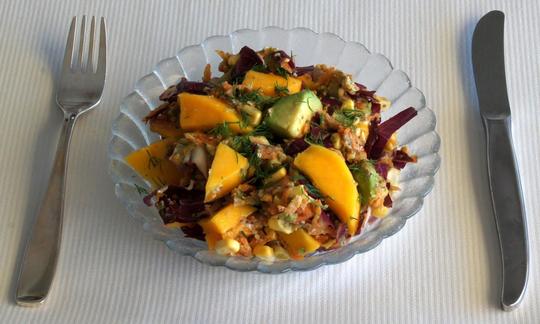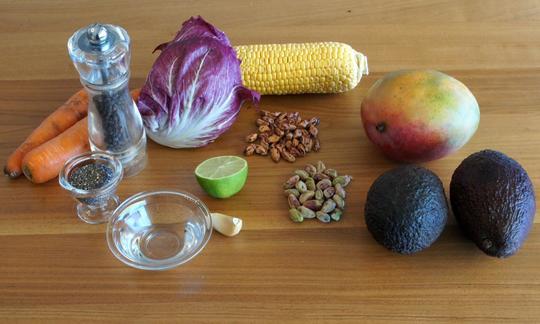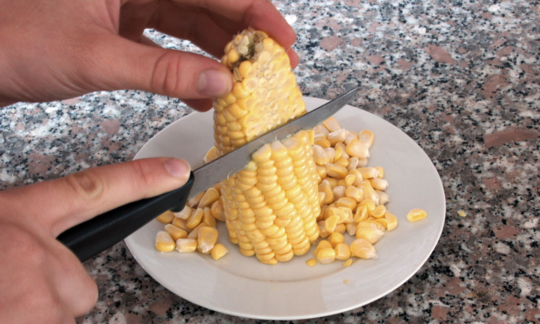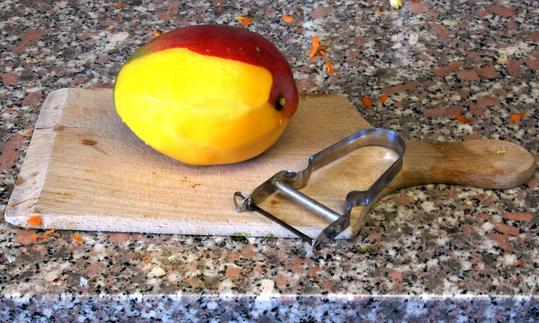Batavia salad with vegetables and mango in nut-chia dressing
raw-vegan
Ingredients (for servings, )
| For the salad | |
|---|---|
| 1 | Batavia lettuce (crisphead group), raw, organic? (14 oz) |
| 2 | Carrots (carrots), raw (organic?) (4.3 oz) |
| 1 | Corn cobs, raw (sweet corn, organic?) (11 oz) |
| 2 | Avocados, raw (organic?) (14 oz) |
| 1 | Mango, raw (organic?) (12 oz) |
| For the dressing | |
| ½ | Limes, raw (organic?) (1.2 oz) |
| 50 ml | Drinking water, raw (organic?) (1.8 oz) |
| 2 tbsp | Chia (chia seeds), raw, organic? (0.37 oz) |
| ⅛ cup | Peanuts (raw?, organic?) (0.64 oz) |
| ⅛ cup | Pistachios, raw (organic?) (0.54 oz) |
| 1 clove | Garlic (organic?) (0.11 oz) |
| ¼ bunch | Parsley, fresh, raw (leaf parsley, parsley) (0.26 oz) |
| ½ tsp, ground | Black pepper (organic?, raw?) (0.04 oz) |
Equipment
- hand-held blender / immersion blender
- grater
- vegetable peeler
- citrus juicer (lemon squeezer)
Type of preparation
- food preparation without heating
- blend
- squeeze
- remove the skin
- peel
- grate (shred)
Preparation
For the salad
Cut out the stalk of the Batavia lettuce. Tear off the leaves, wash them and cut them into fine strips.Peel and wash the carrots and grate them coarsely.
Wash the corn cobs and cut the corn kernels off the cob with a knife.
Halve the avocados, remove the stones, peel and cut into bite-sized cubes.
Avocados are often harvested at the wrong stage of ripeness, handled incorrectly or stored incorrectly, which can lead to rotten spots. When removing the flesh, look for dark spots on the skin or pit and cut out any such spots.
Peel the mango, cut the flesh from the stone and cut into bite-sized cubes. Then place in a serving bowl together with the prepared ingredients for the salad.
For the dressing
Squeeze the lime with a citrus press. Put the lime juice, water, chia seeds, nuts (peanuts, pistachios) and spices (garlic, parsley, black pepper) in a blender glass and mix until smooth.To improve the consistency: Take a few cubes of avocado and mango from the serving bowl and mix it with the dressing (volume ratio: avocado & mango to dressing approx. 1 to 4).
For serving
Pour the dressing into the serving bowl and mix with the salad.For optical refinement
Cut the red pepper into fine cubes and sprinkle over the salad.
|
Nutritional Information per person
Convert per 100g
|
2000 kcal | |
|---|---|---|
| Energy | 508 kcal | 25.4% |
| Fat/Lipids | 23 g | 32.5% |
| Saturated Fats | 3.2 g | 16.1% |
| Carbohydrates (inc.dietary fiber) | 73 g | 27.1% |
| Sugars | 17 g | 18.4% |
| Fiber | 16 g | 65.3% |
| Protein/Albumin | 12 g | 23.5% |
| Cooking Salt (Na:61.8 mg) | 157 mg | 6.5% |
| Essential micronutrients with the highest proportions | per person | 2000 kcal | |
|---|---|---|---|
| Vit | Folate, as the active form of folic acid (née vitamin B9 and | 181 µg | 90.0% |
| Vit | Vitamin K | 62 µg | 83.0% |
| Min | Copper, Cu | 0.64 mg | 64.0% |
| Vit | Vitamin B6 (pyridoxine) | 0.89 mg | 64.0% |
| Vit | Vitamin C (ascorbic acid) | 51 mg | 63.0% |
| Elem | Potassium, K | 1'137 mg | 57.0% |
| Prot | Threonine (Thr, T) | 0.47 g | 51.0% |
| Prot | Tryptophan (Trp, W) | 0.12 g | 48.0% |
| Min | Manganese, Mn | 0.90 mg | 45.0% |
| Prot | Leucine (Leu, L) | 1.1 g | 44.0% |
Detailed Nutritional Information per Person for this Recipe
The majority of the nutritional information comes from the USDA (US Department of Agriculture). This means that the information for natural products is often incomplete or only given within broader categories, whereas in most cases products made from these have more complete information displayed.
If we take flaxseed, for example, the important essential amino acid ALA (omega-3) is only included in an overarching category whereas for flaxseed oil ALA is listed specifically. In time, we will be able to change this, but it will require a lot of work. An “i” appears behind ingredients that have been adjusted and an explanation appears when you hover over this symbol.
For Erb Muesli, the original calculations resulted in 48 % of the daily requirement of ALA — but with the correction, we see that the muesli actually covers >100 % of the necessary recommendation for the omega-3 fatty acid ALA. Our goal is to eventually be able to compare the nutritional value of our recipes with those that are used in conventional western lifestyles.
| Essential fatty acids | per person | 2000 kcal |
|---|---|---|
| Linoleic acid; LA; 18:2 omega-6 | 4.3 g | 43.0% |
| Alpha-Linolenic acid; ALA; 18:3 omega-3 | 0.72 g | 36.0% |
| Essential amino acids | per person | 2000 kcal |
|---|---|---|
| Threonine (Thr, T) | 0.47 g | 51.0% |
| Tryptophan (Trp, W) | 0.12 g | 48.0% |
| Leucine (Leu, L) | 1.1 g | 44.0% |
| Isoleucine (Ile, I) | 0.44 g | 36.0% |
| Phenylalanine (Phe, F) | 0.56 g | 36.0% |
| Valine (Val, V) | 0.59 g | 36.0% |
| Lysine (Lys, K) | 0.51 g | 27.0% |
| Methionine (Met, M) | 0.21 g | 23.0% |
| Vitamins | per person | 2000 kcal |
|---|---|---|
| Folate, as the active form of folic acid (née vitamin B9 and | 181 µg | 90.0% |
| Vitamin K | 62 µg | 83.0% |
| Vitamin B6 (pyridoxine) | 0.89 mg | 64.0% |
| Vitamin C (ascorbic acid) | 51 mg | 63.0% |
| Vitamin A, as RAE | 347 µg | 43.0% |
| Thiamine (vitamin B1) | 0.45 mg | 41.0% |
| Niacin (née vitamin B3) | 5.7 mg | 35.0% |
| Pantothenic acid (vitamin B5) | 2.1 mg | 35.0% |
| Vitamin E, as a-TEs | 4.0 mg | 34.0% |
| Riboflavin (vitamin B2) | 0.34 mg | 24.0% |
| Biotin (ex vitamin B7, H) | 6.5 µg | 13.0% |
| Essential macroelements (macronutrients) | per person | 2000 kcal |
|---|---|---|
| Potassium, K | 1'137 mg | 57.0% |
| Phosphorus, P | 276 mg | 39.0% |
| Magnesium, Mg | 143 mg | 38.0% |
| Calcium, Ca | 86 mg | 11.0% |
| Sodium, Na | 62 mg | 8.0% |
| Essential trace elements (micronutrients) | per person | 2000 kcal |
|---|---|---|
| Copper, Cu | 0.64 mg | 64.0% |
| Manganese, Mn | 0.90 mg | 45.0% |
| Zinc, Zn | 2.6 mg | 26.0% |
| Iron, Fe | 3.5 mg | 25.0% |
| Selenium, Se | 12 µg | 22.0% |
| Iod, I (Jod, J) | 3.7 µg | 2.0% |
| Fluorine, F | 18 µg | 1.0% |
This Batavia salad with vegetables and mango in a nut-chia dressing is a great starter. Possible vegetable variations leave no room for monotony.
Separating the corn kernels from the cob: You don't have to separate the corn kernels from the cob one by one by hand. They can be cut off very easily with a knife. To do this, place the cob on a non-slip board with the tip facing upwards. Then slowly cut off the kernels from top to bottom with a sharp knife, as shown in one of the recipe pictures.
Batavia lettuce: Batavia lettuce is a cross between head lettuce and iceberg lettuce. When buying it, make sure that the outer leaves are firm and not wilted. Unlike other lettuces, it stays fresh and crisp for longer, even with dressing. It can be stored in the refrigerator for up to five days.
Chia seeds: Chia seeds are rich in omega-3 fatty acids, antioxidants, fiber, minerals and vitamins. They absorb a lot of liquid, which is why they create a lasting feeling of satiety. If you soak chia seeds in water, a jelly-like mass is created that you can use, for example, to thicken dressings or sauces.
Pistachios: Pistachios have a high fat content, which is mainly made up of unsaturated fatty acids. The nutrient-rich kernels of the pistachio tree are among the oldest flowering cultivated plants and are known as a special delicacies in the Orient. Traditionally, they are dried in the sun after the harvest, but for larger exports they are sent to processing plants, which means that an impact on the taste cannot be ruled out.
Mangos: The ripe fruits of the evergreen mango tree can weigh up to 2 kilograms. The coloring can vary greatly, but is usually a combination of red, yellow and green. The colorful fruit peels can cause skin irritation as allergens, but the peeled mango can be eaten without any problems by allergy sufferers.
Store pistachios correctly: Pistachios should be stored in a cool, dry place. Storing them at room temperature quickly leads to rancidity, as the lipids break down through oxidation processes. However, if stored correctly, pistachios can be kept for several months without any problems. Alternatively, you can freeze pistachios, which can extend their shelf life even further.
Ripeness of mangos: The ripeness of a mango can be determined by its texture and smell. Ripe mangos can be recognized by their fruity, sweet scent. The fruit should give slightly when lightly pressed. Unripe mangos, on the other hand, are hard, similar to avocados.
Carrots: If you don't like the sweetness of grated carrots, you can also cut the carrots into small cubes. Small carrot cubes also give the salad a little more "bite". In the case of organic carrots, you can also use the peel without peeling it.
Vegetables and nuts: You can add to or replace as you wish. For example, walnuts and hazelnuts go well with salad. Combinations with peppers, tomatoes and cucumbers are also easy to implement and provide a refreshing change.










